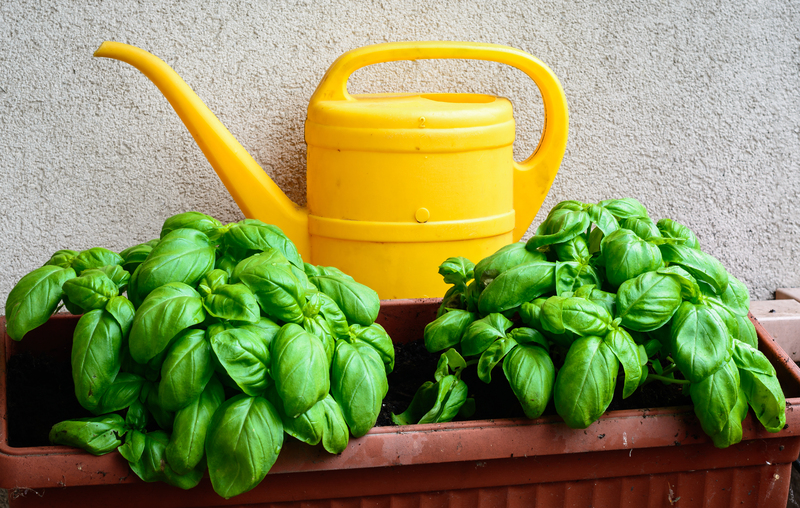Orchid Care Demystified
Posted on 24/06/2025
Orchid Care Demystified: Your Complete Guide to Happy Orchids
Have you ever wondered why some orchid growers seem to have a magical touch, while others struggle to keep their exquisite blooms alive? Fear not--caring for orchids is not as mysterious as it seems. In this comprehensive guide, we'll demystify orchid care and equip you with proven strategies to nurture healthy, thriving plants. Whether you're a beginner or have already tried your luck with these stunning flowers, you'll discover practical tips that will make your orchid-growing journey a success.

Understanding Orchids: Not All Are Created Equal
Orchids comprise one of the largest plant families in the world, with over 25,000 species and more than 100,000 hybrids. It's crucial to recognize that not all orchids have the same care requirements. When striving for the best orchid plant care, you should always start by identifying the specific type of orchid you own.
Common Types of Orchids in Home Cultivation
- Phalaenopsis (Moth Orchid): Easy-to-grow, widely available, and known for their long-lasting flowers.
- Cattleya: Famous for their bold colors and exquisite scent, often called "the queen of orchids."
- Dendrobium: Versatile with many varieties, some deciduous and some evergreen.
- Oncidium (Dancing Lady): Recognizable by their intricate, frilly flowers.
- Vanda: Known for their striking blooms and extensive root systems, often grown in baskets.
Tip: Always check the plant label or consult a nursery expert when buying a new orchid to ensure correct identification and targeted orchid flower care.
The Essential Factors of Orchid Care
Understanding the core elements of successful orchid cultivation is your first stepping stone. Most orchids, especially popular houseplant varieties, share several key needs: the right amount of light, proper watering techniques, specific humidity levels, ideal temperature ranges, and suitable potting media.
1. Light: The Power Behind Beautiful Blooms
Orchids need plenty of light to thrive, but direct sunlight can scorch delicate leaves. Balancing light requirements is crucial for optimal orchid care.
- Phalaenopsis and Paphiopedilum: These prefer low to moderate, indirect light--an east or north window is ideal.
- Cattleya and Vanda: These crave brighter, filtered light and tolerate a little direct sun, especially in the morning.
- Tip: If leaves are dark green, the plant may need more light; if they're yellowish or sunburned, reduce exposure.
2. Watering: Avoiding the Number One Mistake
Overwatering is the most common misstep for new orchid growers. Unlike many houseplants, most orchids are epiphytes, naturally growing on trees with their roots exposed to air. They hate soggy conditions.
- Water when the potting medium is almost dry. For Phalaenopsis and similar types, this may be every 7-10 days, but adjust based on your home conditions.
- Always use room temperature water and avoid letting water pool in the plant's crown to prevent rot.
- Avoid routine watering schedules; instead, get a feel for your orchid's needs.
- Pro Tip: Stick your finger about an inch into the potting mix--if it's dry, it's time to water.
3. Humidity and Airflow: The Tropical Secret
Most orchids flourish in humid conditions--ideally, between 40% and 70% relative humidity. In heated or air-conditioned homes, humidity often drops much lower.
- Group plants together to create a microclimate of higher humidity.
- Use a pebble tray filled with water beneath the orchid (without letting roots sit in water) to raise humidity.
- Regular misting can help, but be sure to do it in the morning so leaves dry off by evening.
- Keep air moving around the plant to thwart fungal diseases. A small fan on a low setting does wonders.
4. Potting Media and Repotting Orchids
Unlike traditional houseplants, orchids need specialty potting mixes that allow for maximum aeration and drainage.
- Popular media include bark, sphagnum moss, charcoal, perlite, and coconut husk chips.
- Repot your orchid every 1-3 years, or whenever the media breaks down and holds too much moisture.
- Choose pots with ample drainage holes. Clear plastic pots allow you to monitor root health and moisture.
5. Feeding Orchids: Less is More
Orchids have modest nutrient requirements. The classic mantra is: "weakly, weekly." Use a balanced orchid fertilizer diluted to quarter- or half-strength compared to label recommendations.
- Feed during the active growth phase (typically spring and summer), and reduce or stop fertilizing in fall and winter when the plant is resting.
- Flush the potting medium with plain water every few months to prevent fertilizer salt build-up.
Addressing Common Orchid Problems
1. My Orchid Isn't Blooming!
Failure to rebloom is a frequent concern. The most common reasons are:
- Lack of sufficient light--try a brighter spot (without direct midday sun).
- Improper temperatures--many orchids require a nighttime drop in temperature to trigger spindle formation.
- Not enough rest--overfeeding and overwatering can prevent orchids from entering their natural rest phase.
Patient orchid care will eventually reward you with beautiful blooms!
2. Yellow Leaves or Soft, Mushy Roots
This is often a sign of overwatering or poor drainage. Repot the orchid in fresh media and trim away affected roots with sterile scissors. Allow the plant to dry slightly before resuming careful watering.
3. Pest Infestations
- Watch for spider mites, mealybugs, and scale insects. Wipe leaves with a damp cloth and treat persistent infestations with insecticidal soap or horticultural oil--never use harsh chemicals intended for outdoor use.
Advanced Orchid Care Tips
Understanding Rest Periods
Some orchids, such as certain Dendrobiums and Cattleyas, need a distinct cool, dry rest period to prepare for their next bloom cycle. Research your orchid's natural cycle and adjust care accordingly.
Encouraging Re-Blooming
- After blooms fade, trim the flower spike for Phalaenopsis above the node closest to the base. This may stimulate a secondary spike.
- For most other types, cut spent spikes at the base to conserve the plant's energy.
Supporting Healthy Roots
Healthy orchid roots appear white or green and are often visible above the pot surface. Don't bury aerial roots; they're adapted to absorb moisture from the air and are vital to the plant's health.
Repotting Without Fear
- Don't wait until your orchid is in distress! Proactive repotting keeps roots healthy and prevents rot.
- Gently remove old potting material, trim away dead roots, and reuse only clean, fresh media.
The Benefits of Growing Orchids: Beauty and More
Beyond their stunning appearance, orchids offer many benefits:
- Air purification: Some studies indicate that orchids help remove pollutants from indoor air.
- Therapeutic value: Tending orchids can relieve stress and boost mood.
- Customization: With such a broad variety, there's an orchid suitable for every home and growing skill level.

Frequently Asked Questions About Orchid Plant Care
Q: Is orchid care difficult for beginners?
No! Orchid care may seem intimidating, but once you understand your plant's basic requirements, they're as simple as any houseplant. Start with a forgiving species, like Phalaenopsis, to build your confidence.
Q: How often should I water my orchid?
Watering frequency depends on environmental factors like humidity, temperature, and the potting mix. Generally, water when the potting medium is nearly, but not completely, dry. Avoid watering on a strict schedule.
Q: What does it mean if my orchid has wrinkled leaves?
This typically signals a root problem--often underwatering, but occasionally root rot from overwatering. Inspect roots and adjust care as needed.
Q: Can I grow orchids under artificial lights?
Yes! Modern LED grow lights make it easy to provide the perfect light spectrum for indoor orchid care. Position the lights above the canopy and adjust based on plant response.
Summing Up: Orchid Care is Simpler Than You Think
You don't need a green thumb to enjoy spectacular orchids. With the right balance of light, water, humidity, and proper potting techniques, you'll discover just how rewarding orchid cultivation can be. Remember, observe your plant--it will tell you what it needs, and with time, orchid care becomes second nature.
Ready to cultivate your own orchid paradise? With these demystified tips, expert advice, and a little patience, anyone can grow and enjoy lush, blooming orchids at home. Start with one, let your collection grow, and turn your space into a botanical oasis!
For more advice and inspiration, explore our other guides on basic orchid care, indoor orchids, and troubleshooting orchid problems. Happy growing!

